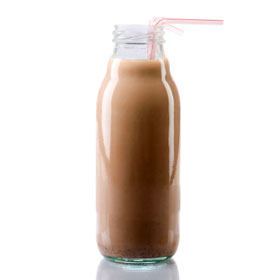-
The Skinny on 6 Snack Picks
Our 'Friend in Food', Theresa Albert (DHN & RNCP), gives us the need-to-know on the top 6 snack picks.
-
Chocolate Milk
The movement away from sports and energy drinks towards chocolate milk is popular with trained athletes who believe it to be ‘the best thing'. There was one small study done to ascertain if muscle recovery happens more quickly after a sports drink, or after chocolate milk. Why chocolate milk and not regular milk, and why just compared to the sugar/salt water of energy drinks? The minerals plus carbohydrates combined with protein in milk has the edge in muscle recovery, but you don't really need the chocolate and sugar of chocolate milk. It has 40 extra calories that come from mostly high-fructose corn syrup (we don't like that) plus a little shot of caffeine from the chocolate. None of these are required to recover from sport. Unless you're raising a true three hour-a-day elite athlete, these items can set back some of the calorie-burning benefits reaped from dance class. Instead, go for regular milk and a banana. They have all the nutrients, protein and carbs needed to rebuild muscle and re-hydrate.

-
Yogurt
You probably know all about how probiotics are good for digestion and immunity. That part is true, but there is more to the yogurt story. The probiotics, or ‘good bacteria', do actually help break down food as well as line the intestine to prevent stomach bugs. The bad news is that most yogurts are made with so much sugar they are working against you. Sugar actually feeds the bad bacteria to effectively keep them alive to do harm for one more day. You do want probiotics from your food, but you want to be careful of the vehicle. Choose plain Greek yogurt that's sweet and creamy all on its own. To add flavour, try a drop of pure vanilla extract and/or cinnamon, or find some jam or compote that has little sugar added and stir it in. Another option—find other fermented foods to feed your kids (and yourself) like miso soup and sauerkraut—they are great boosters.
-
Granola Bars
Label reading matters in this category more than most. The calories range from 125 to 350—that may or may not make a difference to your child, but at the higher end, that number rivals a whole meal that offers so many more nutrients. The kind of calories (and what comes with them) is what's at issue. Look for words like ‘glucose-fructose' ‘sugar' ‘liquid invert sugar' and any other words that end in ‘ose'. Add them up—there shouldn't be more than one. If there is, it's likely a hoodwink to move ‘sugar' down the ingredient list by dividing up the types. Instead, make sure a whole grain is number one on the list, that there are at least two grams of fibre per serving, and there is no more than one source of sugar. Better yet, bake your own muffins, bars and squares.
-
Fish Crackers
They're a staple kid food (which may, in fact, be their downfall). It isn't that there is anything particularly bad in them—there's no food colouring or trans fats, as well as little sugar, but could you do better? Yes. Consider that 55 crackers holds 140 calories—about ⅓ of them from processed fat, and the rest from white flour. There is less than one gram of fibre for all of that ‘snack'. And although some brands now have a ‘whole-grain' version, keep in mind that it is still highly processed. When you think about what wheat is supposed to provide (roughage, carbohydrates and nutrients), this isn't the place to get it. Instead, find crackers with as few ingredients as possible that start with ‘whole grain'. Woven wheats are a better bet.
-
Fruit Cups
Read carefully, and you'll find that your fruit is often packed in ‘light syrup' (which is essentially the same stuff they pour into the ‘juice cocktails' that you already know to avoid). It's nothing more than sugar—or worse—high-fructose corn syrup. One cup of mandarin oranges contains 103 bright, useful calories. One cup of orange sections in light syrup contains 154 calories, 51 of which are completely useless and possibly damaging. Instead, buy, peel and eat fresh fruit or at least be sure that any fruit is packed in real fruit juice, which is marginally more nutrient dense for its added caloric heft.
-
Breakfast Cereal
This stuff isn't just for breakfast any more—baggies and boxes go everywhere. They might be easy meals, but the sugar in some cereals (even the ‘healthy' ones) equals that of a couple cookies. Some cereals have as much sodium as a handful of crackers. Instead, read cereal labels carefully and use them judiciously. Keep the number of grams of fibre as close to the number of grams of sugar as possible. A good cereal should have at least 4 grams of fibre per serving and under 10 grams of sugar. Sodium should stay under 100 mg. Use cereal as a dry snack and not as a breakfast food and you should be OK.